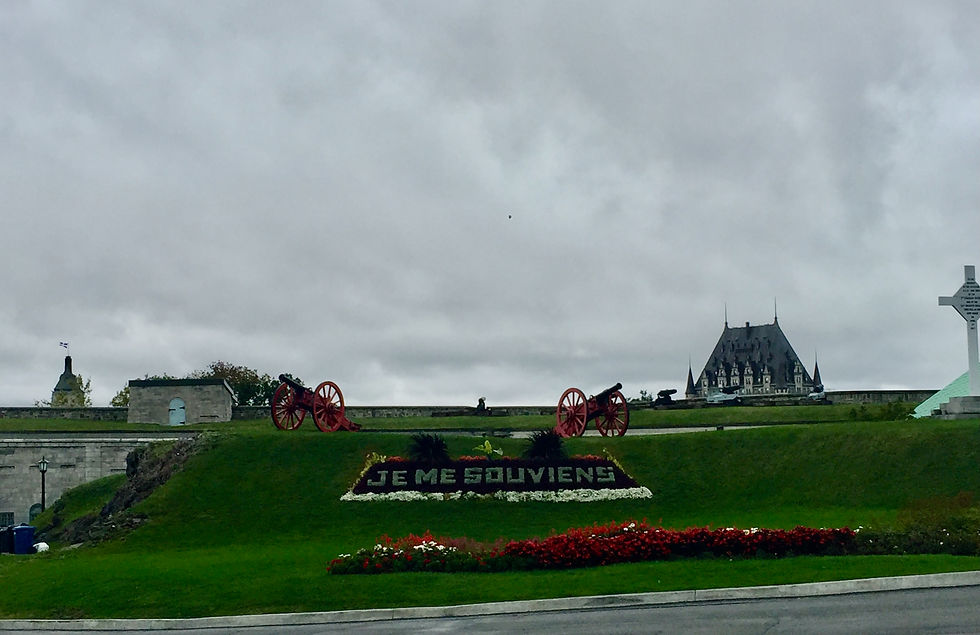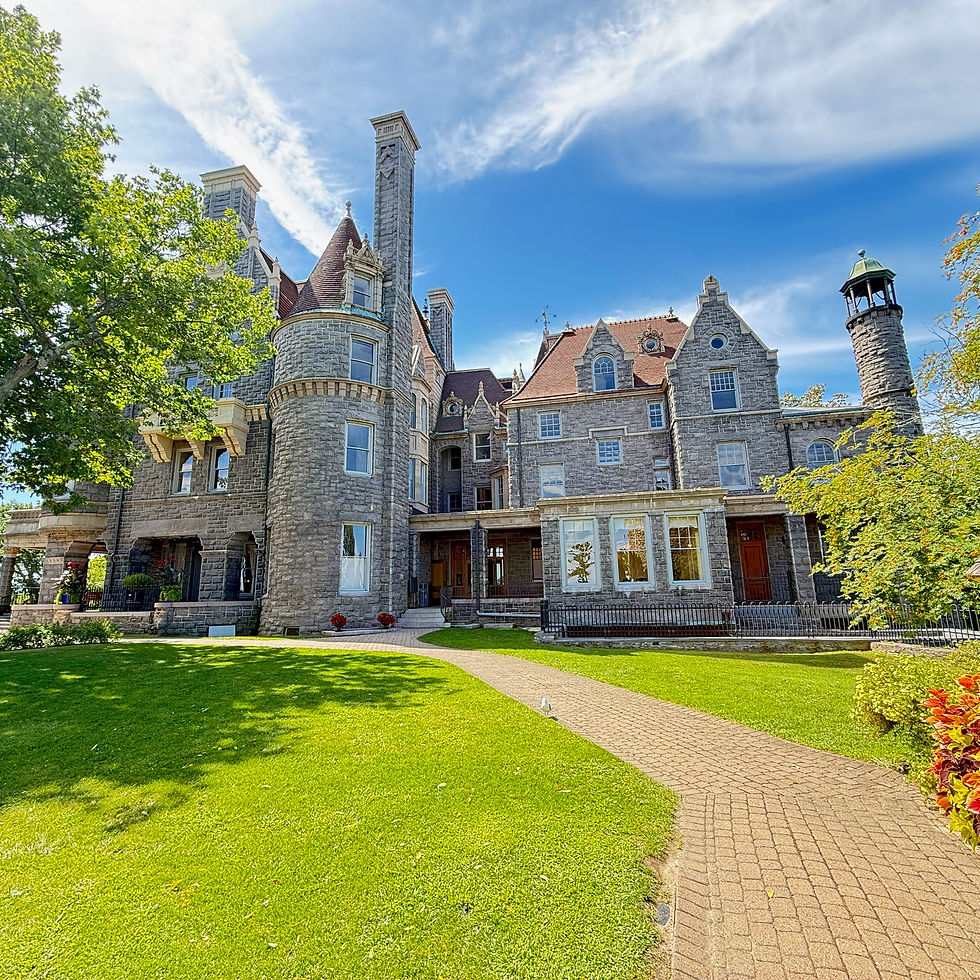Falling in Love with Old Quebec City
- Kim Martinez

- Aug 21
- 5 min read

We visited Old Quebec City and despite parking nightmares, intense heat and crowds, we were not immune to the European charm and centuries of history that were literally everywhere!
The Great Parking Adventure (Our Grand Entrance)
Traveling with an oversized truck in historic city centers always presents challenges, and Quebec City proved no exception. Most downtown parking hides in multi-level garages designed for compact European-style vehicles, not our North American beast.
I'd done my homework, googling open parking lots in advance, but Murphy's Law prevailed—they were either full or blocked by construction detours. What followed was an unintentional extended tour of Quebec City beyond the famous walls.
While Manny, our designated driver, grew increasingly frustrated with the maze of heavy traffic, construction zones, and one-way streets, I found myself enchanted by this unexpected architectural tour. The mix of building styles, tree-lined streets, public gardens, and impressive heritage homes created a visual feast I could have enjoyed for hours. The passenger seat definitely had the better deal during this adventure!
Parking Meter from Hell
Eventually, we discovered a parking spot with a meter in front of a random building, within reasonable walking distance of Old Quebec. Victory, right? Not quite.
The parking meter, like many throughout Quebec, offered instructions only in French. We methodically worked through the steps multiple times, and just when success seemed within reach, the machine would time out with a decisive "Paiement refusé"—even we could decipher that rejection!
Just as defeat loomed, another driver parked behind us and became our inadvertent savior. He showed us the hidden English help button (invisible unless someone points it out) and demonstrated the crucial final step we'd been missing: after inserting the credit card and completing the familiar process, you must remove the card and "tap it" again.

Success! Well, almost. The machine spat out our parking pass and immediately sucked it back in like some mechanical practical joke. Determined not to give up and confidently armed with the new knowledge of the English button using some quick reflexes—we managed to snag the actual parking pass, though we did end up paying twice for the privilege—about $48 total for our Quebec City parking education.

A Living Fortress: Architecture and History
Quebec City holds a unique distinction as the only fortified city north of Mexico, with its impressive walls and fortifications embracing Old Québec like a protective embrace. We began our exploration walking past the star-shaped Citadel, an imposing fortress built between 1820-1850 to protect Quebec from an American invasion that never materialized. The irony wasn't lost on us as we hiked up and walked on top of these very walls that once represented such serious military concerns. The views were impressive!

These impressive fortifications tell a story spanning over 250 years. This British fortress is the biggest built by the British in North America. Walking along these ramparts, you're literally tracing the footsteps of history.
The city's architectural treasures seem to appear around every corner. The Parliament Building, completed in 1877, stands as Québec's oldest national historic site—a testament to the province's political heritage.

The iconic Château Frontenac, built in 1893, rises majestically above the city and holds the distinction of being considered the most photographed hotel in the world. This prestigious castle-like hotel has become synonymous with Quebec City's skyline.

But perhaps no building captures Quebec's layered history quite like the City Hall of Quebec City (Hôtel de ville de Québec). This remarkable building serves as headquarters for the local government and holds special historical significance—it was built on the foundations of the former Jesuit College founded in 1635. The building's importance is recognized nationally and internationally, having been designated a National Historic Site of Canada in 1984 and earning a spot on the World Heritage Site list in 1985. Walking past it, you're literally standing above centuries of Quebec's educational and governmental history.


The streets were filled with buildings like the Morgane Hôtel, housed in the former Hotel Clarendon Wing. The Clarendon claimed fame as Canada's oldest continuously operating hotel (founded in the 1860s) until its recent closure and rebranding. But the building's story reaches much deeper—its oldest section dates to around 1750, originally serving as a merchant's house or warehouse long before hospitality became its calling.



Menu Adventures: Discovering Quebec's Culinary Identity

We found ourselves in that awkward between-meals time, wandering from restaurant to restaurant, studying menus with the curiosity of food anthropologists. Several distinctly Quebecois items appeared repeatedly, each telling its own cultural story:
Salmon Tartare graced nearly every menu—finely chopped raw salmon artfully mixed with seasonings, representing Quebec's abundant maritime heritage.
Poutine made its familiar appearance (we'd become acquainted with this comfort food in Newfoundland). Far more than just "gravy on fries," poutine is Quebec's beloved national dish: crispy fries, squeaky cheese curds, and rich brown gravy. Born in rural Quebec during the 1950s, it's become an iconic symbol of the province's unpretentious culinary spirit.
Tourtière - Quebec's traditional meat pie—typically filled with minced pork, veal, or beef, and especially cherished during Christmas and New Year celebrations. Along Lac-Saint-Jean's shores, you'll find seafood versions with heartier crusts.
Pâté Chinois appeared as Quebec's answer to Shepherd's Pie, featuring distinct layers of ground beef, corn, and mashed potatoes.
Soupe aux pois—a robust pea soup made with dried yellow peas and salted pork—promised the kind of warming comfort food that built this hardy province.
Ok, let's be real. Those descriptions are trying to sound positive and I am certain that these menu items will appeal to many but being a pescetarian and not embracing raw salmon, the menu was not tempting to either of us. However, we did bond with the beautiful dessert displays and cafes featuring flaky croissants and delicate pastries. We went into several potential winners but the long lines encouraged us to keep exploring.
When Weather Intervenes
As we headed back toward our parking spot, the first drops of rain felt like a blessing against the August heat. But Quebec weather, like the city itself, has dramatic flair—within minutes, the gentle relief became a proper downpour. It's funny how quickly you can transition from hot and miserable to comfortable to wet and miserable. We're admittedly picky about our weather comfort!
The rain made our decision easy: time to retreat and head back.
Quebec City reminded us that every corner holds stories, every building layers history upon history, and sometimes the best discoveries happen when your plans go slightly awry. Rain, parking adventures, and all—we left completely charmed by this remarkable fortress city.


---







Comments